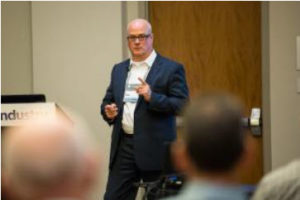
Bill Metz, V.P. of Operations, was recently asked to discuss the industrial valve manufacturer’s campaign to improve plant-floor visibility at the Smart Industry 2017 presentation. “Digital transformation is all about real-time information enabling operators to run their parts properly and enabling management to determine what is the best strategy for the company, keeping the business case in mind.” Bill stressed that a thoughtful, phased approach to implementing the IIoT elements is critical to staying competitive.
Bill Metz stated that Richards Industries began its smart-factory journey back in the 1990’s, with the adoption of lean-manufacturing practices. Those habits evolved over the years into a robust digital-transformation strategy, with the latest element being an aggressive program, launched in 2015, employing a Forcam productivity-software solution to improve overall Equipment Effectiveness (OEE). This program was piloted on ten Richards Industries machines – gathering and visualizing performance data of the equipment and its operators. The initiative quickly boosted productivity, decreased downtime and reduced waste while recording a solid return-on-investment; early wins that prompted a rollout of the effort across the company. The implementation cost for this program was about $60,000. The benefits continue to be realized.
Newfound Visibility
Metz claimed that the best insight he got from newfound visibility into his equipment was the ability to see how infrequently spindles were turning on some machines. This problem was quickly corrected – they installed triggers on machines that sent downtime alerts to operators and returns were immediate. “It is critical to determine who gets what report and to make these reports as actionable as possible,” he said.
There were surprises and lessons learned, of course. Additional expenditures. Missed deadlines. An initial reluctance from workers who perceived these improvements as threats. In the end, those fears were unfounded. There were no layoffs. Productivity rose. Personnel readily adapted to the new processes, in part because management included representatives from every sector in the transition process, making machine operators members of the cross-functional team that oversaw the implementation.’
And, there were plenty of takeaways applicable to any industry. Metz advised properly researching all options, all vendors, before starting such a program, including a comprehensive survey of legacy equipment to be updated. “You must accept additional costs and added time for implementation,” he said.
Four Motivations
Metz outlined four main motivations for shop-floor management in the modern era, what he labeled cornerstones of a successful digital-transformation strategy:
- There must be transparency on the shop floor – What is your uptime? What is the health of your motors? Are you using high-quality parts that result in fast throughput?
- The need for good data. Good data is that which is actionable and role-based so that stakeholders have the information they need to work properly.
- Properly tracking OEE metrics – Are you still measuring these metrics manually, or have you automated this process?
- Challenges related to continuous improvement. Does system and equipment diversity within your enterprise create inconsistencies?
These principles guided Richards Industries through their latest digital transformation. The results are evident. They are gaining deeper insight into production hours. They have better access to real-time data. Machines are being freed up for more work. And personnel have more time to focus on developing business strategies that will drive further improvements.
 Bill Metz, V.P. of Operations, was recently asked to discuss the industrial valve manufacturer’s campaign to improve plant-floor visibility at the Smart Industry 2017 presentation. “Digital transformation is all about real-time information enabling operators to run their parts properly and enabling management to determine what is the best strategy for the company, keeping the business case in mind.” Bill stressed that a thoughtful, phased approach to implementing the IIoT elements is critical to staying competitive.
Bill Metz stated that Richards Industries began its smart-factory journey back in the 1990’s, with the adoption of lean-manufacturing practices. Those habits evolved over the years into a robust digital-transformation strategy, with the latest element being an aggressive program, launched in 2015, employing a Forcam productivity-software solution to improve overall Equipment Effectiveness (OEE). This program was piloted on ten Richards Industries machines – gathering and visualizing performance data of the equipment and its operators. The initiative quickly boosted productivity, decreased downtime and reduced waste while recording a solid return-on-investment; early wins that prompted a rollout of the effort across the company. The implementation cost for this program was about $60,000. The benefits continue to be realized.
Bill Metz, V.P. of Operations, was recently asked to discuss the industrial valve manufacturer’s campaign to improve plant-floor visibility at the Smart Industry 2017 presentation. “Digital transformation is all about real-time information enabling operators to run their parts properly and enabling management to determine what is the best strategy for the company, keeping the business case in mind.” Bill stressed that a thoughtful, phased approach to implementing the IIoT elements is critical to staying competitive.
Bill Metz stated that Richards Industries began its smart-factory journey back in the 1990’s, with the adoption of lean-manufacturing practices. Those habits evolved over the years into a robust digital-transformation strategy, with the latest element being an aggressive program, launched in 2015, employing a Forcam productivity-software solution to improve overall Equipment Effectiveness (OEE). This program was piloted on ten Richards Industries machines – gathering and visualizing performance data of the equipment and its operators. The initiative quickly boosted productivity, decreased downtime and reduced waste while recording a solid return-on-investment; early wins that prompted a rollout of the effort across the company. The implementation cost for this program was about $60,000. The benefits continue to be realized.



